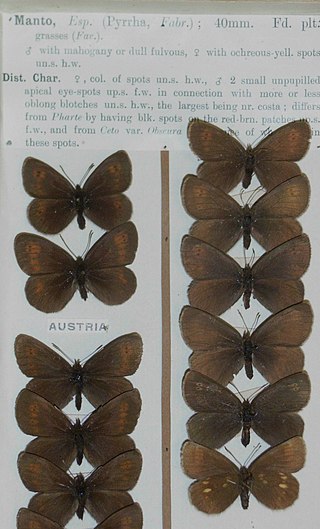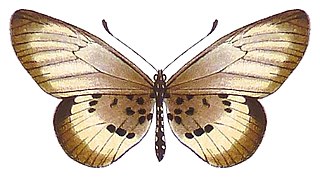
The marbled beauty is a moth of the family Noctuidae. The species was first described by Johann Siegfried Hufnagel in 1766. It is an abundant species throughout most of Europe east to the Urals, and it is probably the most common lichenivorous moth of the Palearctic realm.

The yellow-spotted ringlet is a member of the subfamily Satyrinae of the family Nymphalidae. It is associated with (sub)alpine meadows at 900–2,500 m above sea level. It is found in the Alps, the Pyrenees, the Cantabrian Mountains, the Massif Central, the Vosges Mountains, the Carpathian Mountains and the mountains of Herzegovina.

Grammodes stolida, the geometrician, is a moth of the family Erebidae. The species was first described by Johan Christian Fabricius in 1775. It is found in Africa, southern Europe, most of Asia and Australia. It migrates to central and northern Europe as far north as England, Denmark and Finland.

Earophila badiata, the shoulder stripe, is a moth of the family Geometridae. The species was first described by Michael Denis and Ignaz Schiffermüller in 1775. It is found from most of Europe and North Africa to the Altai Mountains in the east Palearctic.

Acraea lycoa, the lycoa acraea, is a butterfly in the family Nymphalidae which is native to the African tropics and subtropics.

Acraea peneleos, the Peneleos acraea, is a butterfly in the family Nymphalidae, which is native to the tropics and northern subtropics of sub-Saharan Africa.

Acraea pentapolis, also known as the scarce tree-top acraea or eastern musanga acraea, is a butterfly in the family Nymphalidae. It is found in western and central Africa.

Epicephala angustisaccula is a moth of the family Gracillariidae. It is found in China (Hainan).
Rectiostoma argyrobasis is a moth in the family Depressariidae. It was described by W. Donald Duckworth in 1971. It is found in the humid low highlands of northern Venezuela and south-eastern Brazil.
Rectiostoma chrysabasis is a moth in the family Depressariidae. It was described by W. Donald Duckworth in 1971. It is found in Santa Catarina, Brazil.
Rectiostoma cirrhobasis is a moth in the family Depressariidae. It was described by W. Donald Duckworth in 1971. It is found in the humid low highlands of Guatemala and El Salvador.
Rectiostoma earobasis is a moth in the family Depressariidae. It was described by W. Donald Duckworth in 1971. It is found in Bolivia.
Rectiostoma ochrobasis is a moth in the family Depressariidae. It was described by W. Donald Duckworth in 1971. It is found in the humid low highlands of south-eastern Peru and Bolivia.
Rectiostoma silvibasis is a moth in the family Depressariidae. It was described by W. Donald Duckworth in 1971. It is found in Venezuela.
Rectiostoma thiobasis is a moth in the family Depressariidae. It was described by W. Donald Duckworth in 1971. It is found in Brazil.
Rectiostoma xuthobasis is a moth in the family Depressariidae. It was described by W. Donald Duckworth in 1971. It is found in Colombia.
Rectiostoma callidora is a moth in the family Depressariidae. It was described by Edward Meyrick in 1909. It is found in the humid low highlands of south-eastern Peru and north-western Bolivia.
Rectiostoma eusema is a moth in the family Depressariidae. It was described by Lord Walsingham in 1914. It is found in Guatemala.
Rectiostoma haemitheia is a moth in the family Depressariidae. It was described by Cajetan Felder, Rudolf Felder and Alois Friedrich Rogenhofer in 1875. It is found in the humid low highlands of western Venezuela, central Colombia and Costa Rica. It has also been recorded from Panama and Brazil (Amazonas).

Charaxes affinis is a butterfly in the family Nymphalidae. It was described by Arthur Gardiner Butler in 1866. It is found in the Indomalayan realm.









